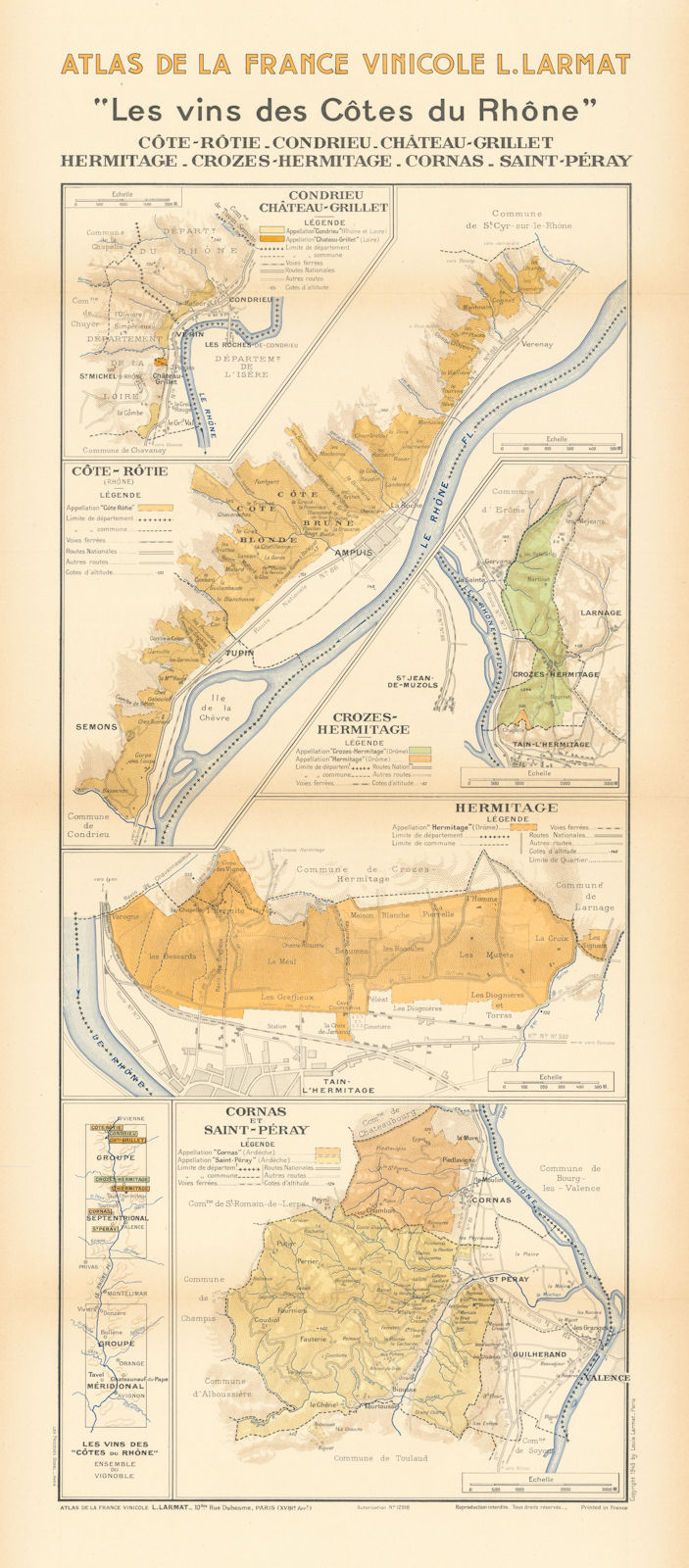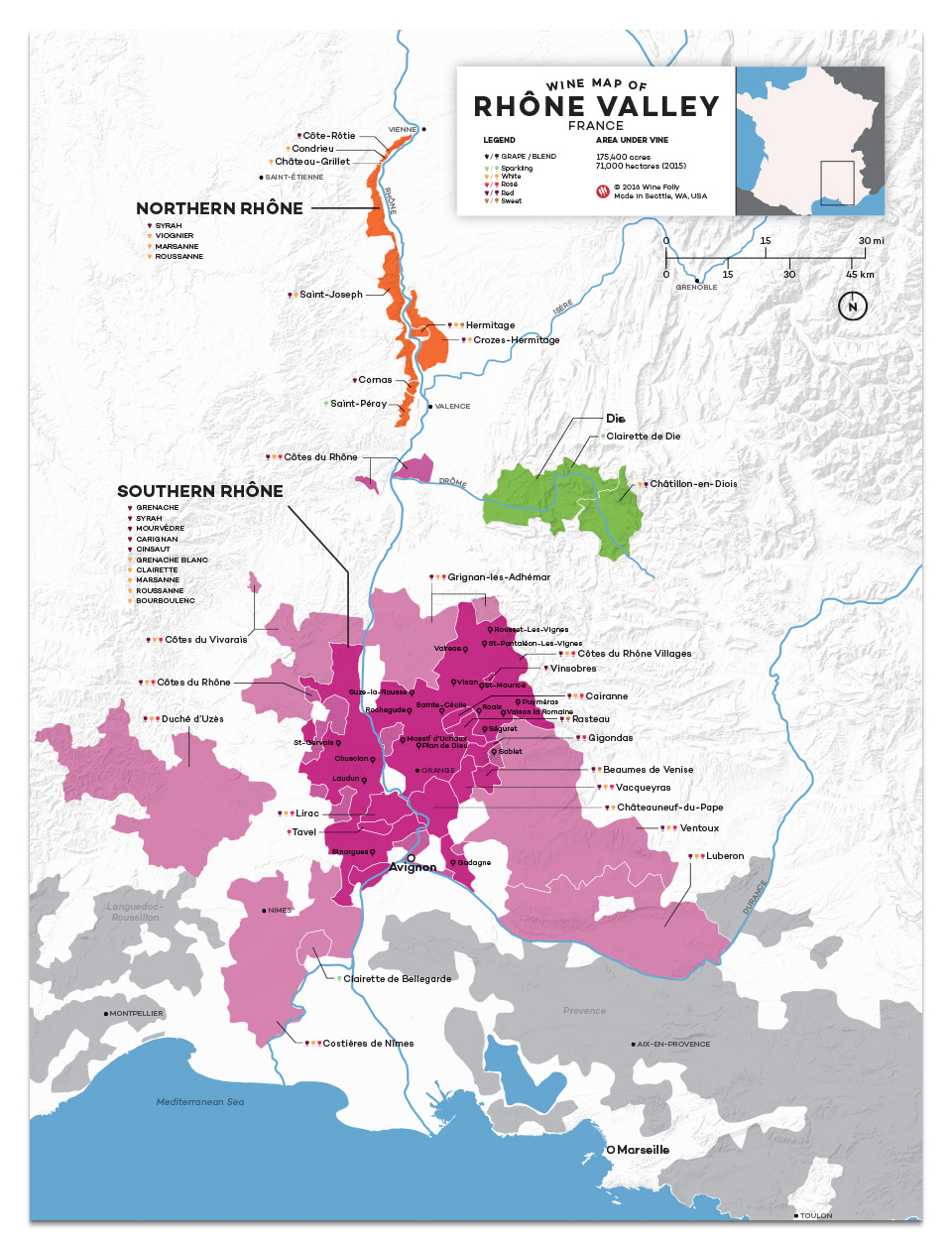- The Côte-Rôtie vineyards grow on slopes on the right bank of the Rhône, across the three communes of Saint-Cyr sur Rhône, Ampuis and Tupin-Semons, and lie between 180 and 325m above sea level. They include 73 officially-registered lieux-dits.
- The Côte-Rôtie vineyards grow on slopes on the right bank of the Rhône, across the three communes of Saint-Cyr sur Rhône, Ampuis and Tupin-Semons, and lie between 180 and 325m above sea level. They include 73 officially-registered lieux-dits.


The terroir of Cote Rotie is quite unique. The most famous vineyards of Cote Rotie are located on two hills, known collectively as Cote Blonde and Cote Brune. You can actually see the differences in the soils when you look at both hills. The soil of Cote Brune is darker in.

Guigal From Roman times to the latter part of the 19th Century the vignoble of Côte-Rôtie enjoyed fame and prosperity. This glory ebbed in decline until the appearance of one family, the Guigals notably Marcel- whose energetic and single-minded pursuit of quality put Côte-Rôtie back on the worlds fine wine map. Marcel Guigals reputation is based on his three single-vineyard wines; intense, powerful yet supremely elegant and with long-life potential. La Mouline: Made from approximately one hectare of Syrah vines in the Côte Blonde, to which is added roughly 11 Viognier. The wine first appeared under the Mouline name in 1966. La Turque: from a hectare on the Côte Brune, including 5 Viognier. Though not planted until 1982, La Turque burst on the scene in 1985, producing a remarkable wine. Its depth and finesse put Guigal firmly on the international fine wine map. La Landonne: from 2 hectares of Syrah on the Côte Brune, replanted in 1974 and subsequently. The wine has been aptly described as the most magisterial of the remarkable trio.
Côte-Rôtie, La Landonne--Vintage 1983
Rhône, E. Guigal
Levels: one 0.5cm, one 1.0cm, one 2.5cm; one missing capsule, all with tattered remains of vintage tag and labels, vineyard and vintage confirmed by handwritten mark on bottle by cellar master prior to label disintegration
3 bottles per lot


The terroir of Cote Rotie is quite unique. The most famous vineyards of Cote Rotie are located on two hills, known collectively as Cote Blonde and Cote Brune. You can actually see the differences in the soils when you look at both hills. The soil of Cote Brune is darker in.
Guigal From Roman times to the latter part of the 19th Century the vignoble of Côte-Rôtie enjoyed fame and prosperity. This glory ebbed in decline until the appearance of one family, the Guigals notably Marcel- whose energetic and single-minded pursuit of quality put Côte-Rôtie back on the worlds fine wine map. Marcel Guigals reputation is based on his three single-vineyard wines; intense, powerful yet supremely elegant and with long-life potential. La Mouline: Made from approximately one hectare of Syrah vines in the Côte Blonde, to which is added roughly 11 Viognier. The wine first appeared under the Mouline name in 1966. La Turque: from a hectare on the Côte Brune, including 5 Viognier. Though not planted until 1982, La Turque burst on the scene in 1985, producing a remarkable wine. Its depth and finesse put Guigal firmly on the international fine wine map. La Landonne: from 2 hectares of Syrah on the Côte Brune, replanted in 1974 and subsequently. The wine has been aptly described as the most magisterial of the remarkable trio.
Côte-Rôtie, La Landonne--Vintage 1983
Rhône, E. Guigal
Levels: one 0.5cm, one 1.0cm, one 2.5cm; one missing capsule, all with tattered remains of vintage tag and labels, vineyard and vintage confirmed by handwritten mark on bottle by cellar master prior to label disintegration
3 bottles per lot
Just as Barolo's traditional icons were re-discovered in the 2000s, the great classicists of Côte Rôtie have today grabbed the world's imagination.
Like Barolo, the Northern Rhone largely faded from the greater wine world's consciousness in the post-WWII era. Historic vineyards were abandoned, or only worked on weekends while their owners made their living in nearby factories, or in other agriculture. It was only in the 1980s, as Guigal's single-vineyard wines began to gain attention, that money began to return to this fabled region.
Of course, many growers returning to full-time winemaking brought with them modern winemaking tools and techniques. And, in rejecting the often-flawed wines of their poorer elders, they also lost much of the singular identity that classical heritage could tease from their 'roasted slopes.' Wines became cleaner, darker, oakier – and less uniquely Côte Rôtie.
Cote Rotie Pronunciation
Yet a few estates flatly rejected modernism and held true to Côte Rôtie's historic character and techniques. So today, as collectors rediscover the glories of Marius Gentaz and his contemporaries, just a handful of estates - including Domaine Jamet and Domaine Rostaing – are making wines that evoke that earlier era.
Humble Beginnings
The Rostaing estate dates to 1971 when René Rostaing– a Notary by trade – began tending a few plots of family vineyards. He had the perfect role model to guide him into a career of classical winemaking: Marius Gentaz, his uncle. Over the next few years, René took advantage not only of his uncle's mentoring, but of historically low vineyard prices, to acquire a prized half acre each in the Côte Blonde and La Landonne lieux-dits.
And when he married, he acquired a second traditional role model, his father-in-law, Albert Dervieux. Dervieux retired in 1989 and Gentaz followed three years later, giving René a further ten acres of very old vines in some of the appellation's top sites. This treasury of vineyards launched René's estate into the stratosphere.
Cote Rotie Vineyard Map
The vineyard expansion also enabled René to quit his day job and to devote himself full time to winemaking. Over the next 25+ years, he crafted a sequence of masterful wines that honored the legacy of his illustrious forebearers.
In 2015, René's son, Pierre, took the reins at an estate that boasts 20+ acres of the finest vineyards in and around Côte Rôtie. And, he shares his father's deep reverence for Côte Rôtie's traditions.
